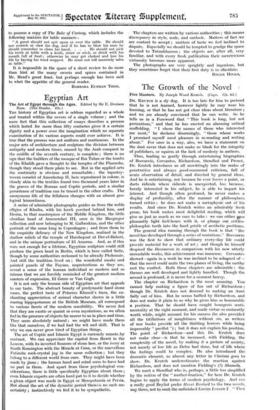Egyptian Art
The Art of Egypt through the Ages. Edited by Sir E. Denison Ross. (The Studio. 42s.)
Tax history of Egyptian art is seldom regarded as a whole and treated within the covers of a single volume ; and the mere fact that this collection of essays describes a process which lasted for more than fifty centuries gives it a certain dignity and a power over, the imagination which no separate examination of its various aspects could ever achieve. It is true that the process was not uniform and continuous. In the major arts of architecture and sculpture the division between antiquity and modern times, caused by the Arab conquest in the middle of the seventh century, is complete ; there is no sign that the builders of the mosque of Ibn Tulun or the tombs of the Khalifs gave a thought to the temples of the Pharaohs, though they stood there plain to see. But in the applied arts the continuity is obvious and remarkable ; the tapestry- woven corselet of Amenhotep II, here reproduced in colour, is closely akin to the textiles found two thousand years later in the graves of the Roman and Coptic periods, and a similar persistence of tradition can be traced in the other crafts. The anonymous life of the fellaheen changes with an almost geo-
logical leisureliness.- ,
A series of admirable photographs guides us from the noble effigies of Khafra, with his hawk perched behind him, and Hesira, to that masterpiece of the Middle Kingdom, the little obsidian head of Amenetnhet III, once in the Macgregor collection and now belonging to M. Gulbenkian, and the other portrait of the same king in Copenhagen ; and from them to the exquisite delicacy of the New Kingdom, realized in, the shallow reliefs of the temple of 'Hatshepsut at Der-el-Bahari, and in the unique portraiture of El Amarna. And, as if this were not enough for 'a lifetime, Egyptian sculpture could-still produce the green head in Berlin, which is here called Saite, though by some authorities reckoned to be already Ptolemaic. And still the tradition lived on ; the wonderful masks' and painted panels of the Fayum, unpretentious as they are, reveal a sense of the human individual so modern and so intense that we are forcibly reminded of the greatest modern
masters of expression, El Greco or Van Gogh. - It is not only the human side of Egyptian art that appeals to our taste. The abstract beauty of predynastic hard stone vases, the perfect taste of Princess Khemit's tiara, the en- chanting appreciation of animal character shown in a little roaring hippopotamus at the British Museum, all correspond to various facets of the modern sensibility. We never feel that they are eXotie or quaint or even mysterious, as we often feel in the presence of objects far nearer tows in place and time. They seem absolutely natural ; we might have made them like that ourselves, if we had had the wit and skill. That is why we can never grow tired of Egyptian things.
The art of Coptic and Islamic Egypt is curiously remote .by contrast. We can appreciate the capital from Bawit in the Louvre, with its inverted flounces of stone lace, or the ivory at South Kensington-with the Miracle at Cana, or the marvellous Fatimite rock-crystal jug in the same collection ; but they belong to a different world from ours. They might have been made by jinns ; the human hand and mind seem to have had no part in them. And apart from these psychological con- siderations, there is little specifically Egyptian about them ; even Islamic experts are often hard put to it to decide whether a given object was made in Egypt or Mesopotamia or_Persia. lint about the art of the dynastic period ther&is no such un- certainty ; instinctively we feel it to be sympathetic.
- The chapters are written by various authorities ; this meting -discrepancy in style, scale, and outlook. Matters of fact iwe are content to accept ; matters of taste we feel inclined to dispute. Especially we should be tempted to grudge the space devoted to Tutankhamen ; the objects are, after all, very familiar, and with every fresh publication their meretricious virtuosity becomes more apparent.
The photographs are very sprightly and ingenious, but they sometimes forget that their first duty is to efficidate.
ROGER HINES;


















































 Previous page
Previous page